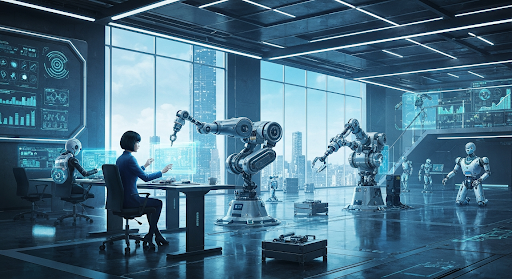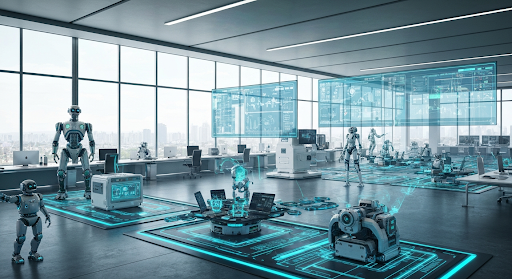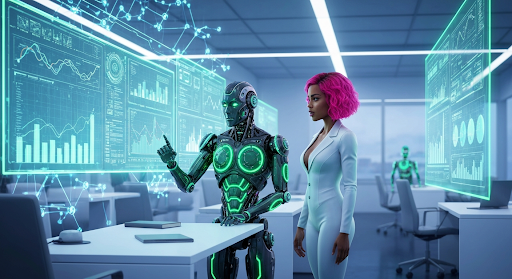What are the benefits of using robots for automation?
What are the benefits of using robots for automation?
Using robots for automation offers several benefits, including increased efficiency, reduced labor costs, and enhanced precision. Robots can perform repetitive tasks with speed and accuracy, reducing human error. Additionally, they can operate continuously without fatigue, leading to higher productivity and the ability to scale operations effectively in various industries.
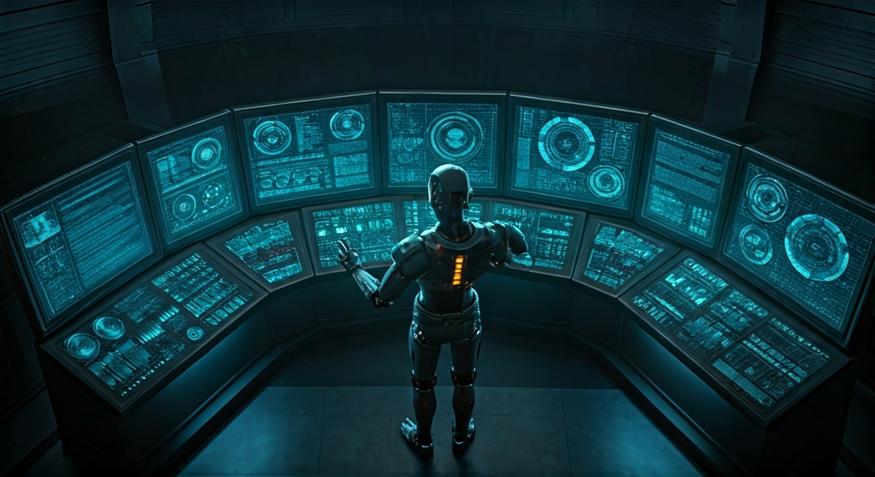
Key Highlights
- Robots are machines that you can program. They work in the physical world and do tasks, from material handling to more difficult jobs.
- Automation is a bigger idea. It uses technology to make work easier, both in real life and in digital spaces. This cuts down how much humans have to do.
- Industrial robots and collaborative robots are changing how people make things, move products, and help in healthcare. They make things go faster and help reduce risks.
- Robotic process automation (RPA) is software that can take over repetitive tasks, like putting in data. This lets people have more time to do better and more important work.
- New trends, like using artificial intelligence with robots, are shaping how automation works in every industry.
- Knowing about robotics and process automation can show you the difference between each one. It also helps you see how they can improve business and cut down on human intervention.
Introduction
Robotic automation is now a key part of today’s industry, both online and offline. It uses robots and process automation to help make business work better by automating complex tasks that are often repeated. With software automation and robotic automation, companies can do more in less time. The teamwork of robotics and automation brings big chances for growth. If you know how these technologies work, you can put your business in a good spot. It helps with new ideas, getting more work done, and growing in this new, automated world.
Next, it is important to know what robots and automation really mean.
Defining Robots and Automation
Robots and automation are both important in making industries better, but they are not the same thing. Robots are machines you can program to work with the physical world. They can change what they do and be very exact in their work. Automation, on the other hand, is about using different technologies to cut down on human intervention. It helps to make processes and places run more smoothly.
These two ideas often come together. Robots usually act as the main machines in automation systems. Robots help with many jobs, from industrial robotics to jobs done on computers, like RPA. Now, let's look at what these terms mean even more.
What Is a Robot?
A robot is a machine that you can program to interact with the physical world and do different jobs. Powered by computer science and engineering, robots have sensors to take in information. They also use actuators to help them move and control systems that work like their brains. These machines are more flexible than those that only do one job. Robots can work well with accuracy in many different areas.
In many fields, industrial robots lead the way. For example, robotic arms on assembly lines are very good at jobs like welding or material handling and packaging. These physical robots help take humans out of dangerous places. This helps keep people safe and makes the work get done faster.
Beyond doing work with their bodies, physical robots have made a big change in shipping, storage, and even at home. Automated cleaners, for instance, help with chores and make life easier. As we mix robotics, computer science, and artificial intelligence, what a robot is and what it can do keeps on growing. There are now many new ways that robots are used in the physical world every year.
What Is Automation?
Automation means using machines, software, or systems to help or sometimes replace what people do. The goal be to make both easy and tough jobs simpler and faster. It can take care of many things, like business process automation, where software makes office work smooth, and industrial automation, where machines and systems handle real-world tasks.
The use of automation goes far beyond the factory floor. For example, companies use software bots in customer service, while robotics help put together things in assembly plants. Most of the time, humans set the limits, because there be certain jobs where you still need people to check or use their own sense to make sure things go right.
Modern automation technology aims to cut down on how much people need to step in. There be smart tools, like rpa tools and intelligent process automation, that use AI to make improvements. As more of these business process tasks join up with smart machines, companies can get jobs done faster and with fewer mistakes. This means they also work with better speed and gain reliability as they blend automation software with human skill, using less human intervention for both simple and complex tasks across physical processes and business process automation
Core Components of Robotic Automation
Robotic process automation (RPA) works by using automation software and simple programmable technology. These tools are made to copy what people do at work. This helps to make the process smooth, lower mistakes, and boost how much he or she can get done.
You often see software robots used in computer systems. But you also get physical robots coming in, especially when businesses want to link smart systems and tools together. Both help give rise to smart process automation options for many jobs and places. Now, let’s look at what robotics is made up of: hardware and software.
Hardware Elements in Robotics
The hardware parts are very important for robotics to work. Robotics depends on mechanical systems. These include robotic arms and actuators so that robots can move, along with sensors for more accurate actions. For example, industrial robotics often use sensors and actuators. These help them pick up and move things in automated warehouses.
When it comes to material handling, robots use computer vision. This lets them interact with what is around them. It also lets them see objects clearly and move them the right way. Because robots can do these physical processes, they work well in making things and shipping them.
Robots are being used for more complex tasks because hardware keeps getting better. Better actuators and lighter materials help robots do many new jobs, like helping with surgeries or missions in tough places. The use of robots to handle delicate work or stay accurate in risky places shows how new hardware is at the heart of robotics.
Software and Control Systems
Software and control systems are like the brain for robots. With automation software such as RPA software and AI, robots can make decisions in a better way. These control systems help guide what robots do. They also help close the gap between human intervention and complete machine control.
RPA software helps run many business and industrial jobs by making things like scheduling and tracking much easier. On the other hand, software robots do virtual tasks. They work smoothly in office settings. These robots take away human errors and make sure that repetitive tasks get done fast.
Modern robots use new software solutions and machine learning to adjust to changing situations. These systems can make quick choices with new data. It helps them work better in many different types of jobs. As automation gets better, better software lets robots take on more tasks and skills.
Types of Robotic Automation
Robotic automation comes in many forms. Each type works well for different jobs. Industrial automation uses robots mainly in factories. These robots help to do the same physical tasks again and again. This way, work goes faster and people are safer.
In the same way, process automation uses software bots to help with office work. These bots do jobs that are like what humans do, such as moving and using data. With AI, robotic automation can also do these tasks in a smarter way. People use these types of robotic automation in many fields, like health, moving goods, and more. They handle complex tasks and offer good solutions for many needs.
Now, let’s look at some special kinds of automation, like industrial robots and collaborative robots.
Industrial Automation Robots
Industrial automation robots change the way factories work by making things faster and more reliable. These programmable machines do repeated jobs well. This helps keep people safe and makes a job get done faster.
- Material handling: These robots move and sort things on their own.
- Assembly and welding: These machines do careful work with very few mistakes.
- Quality control: They use sensors to make sure work meets the standards.
These industrial robots use advanced automation technology to help factories make more products, save money, and run longer. Because they are flexible, factories can work all day and night without losing quality or doing less work.
When you see robots used in industry, you see how automation technology brings together hardware and software. These machines work well, even when things get tough.
Service and Collaborative Robots
Collaborative robots, often called “cobots,” are changing how people work with robots. In factories and offices, these robots work right next to human workers. They keep things safe by watching the environment and changing how they act when needed.
In customer service, robots answer questions from people and help customers find what they need. This lets workers spend more time on jobs that need human judgment or creative thinking. In offices, service robots help with things like setting up meetings or making sure rules are followed. They do these tasks well because they are very exact.
With human-robot collaboration, cobots help people and robots work together in a better way. This balances what people do best with what robots can do. Around the world, cobots make work easier, help things run better, and let people and robots team up. They bring together robotic speed and human insight in many workplaces.
Key Differences Between Robotics and Automation
Robotics and automation work together, but they are not the same. Robotics is about doing physical jobs. These machines can be programmed to do different things and can change depending on what the job needs. Automation covers more types of technology. It often helps things grow beyond just physical processes.
For example, automation can help run business processes with the use of software bots. Robotics is good for jobs where you need human intervention or where the work has to be exact. Both robotics and automation help companies by letting people spend time on bigger plans and goals. Let's look more into how they are different.
Distinctive Functions and Purposes
The functions and purposes of robotics and automation are not the same. Robotics is about working with the physical world. Automation, instead, is used to make repeated jobs go faster and easier. Robotics is good at doing many complex tasks. It can switch between jobs and change how it works. Automation works best when it does the same set of programmed steps again and again.
Human judgment is often needed when using robots. People may watch what the robot does or step in to help if needed. With automation, things are a bit different. It is used to do data tasks in a digital space. Automation helps a lot with things like compliance reporting, using bots or RPA tools to handle the work.
At the end of the day, programmable robotics is flexible and can do many kinds of tasks. Automation is better when you want the job done quickly, with fewer mistakes, and at a lower cost. That’s what makes their uses clear in the business world.
How Robotics and Automation Work Together
In many industries, robotics and automation work together to make everything smoother. Robots do the physical processes, while automation software manages things with virtual process management. The robots act as the hardware you see. The automation software is the system that runs the rules and guides what to do, giving your team scalable software solutions.
| Robotics Aspect | Automation Aspect |
|---|---|
| Physical Processes | Virtual Process Management |
| Human-like Task Interaction | Rule-based Task Handling |
| Programmable Hardware | Scalable Software Solutions |
The mix of robotics and automation gives industries much higher productivity. The setup makes it easy to scale up when you need to and helps lower risks in their work. By using automation software, RPA tools, or robots in assembly lines, companies get the best from both. This pushes their growth forward for years to come.
Emerging Trends in Robotic Automation
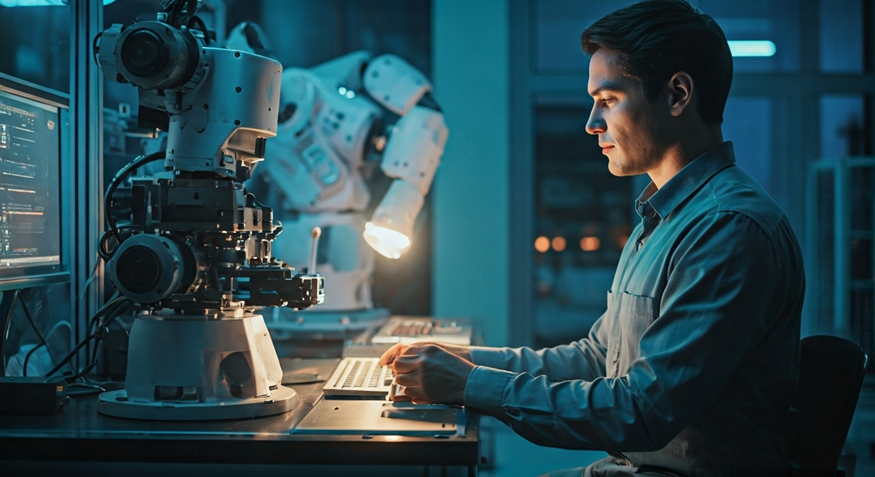
Robotic automation is changing quickly because of digital transformation. Machine learning and artificial intelligence help systems become smarter. These systems can now adjust better to what is needed. Collaborative robots are helping people do their jobs better and are increasing human work skills.
These new trends show that automation will soon become both smarter and easier to use. Many businesses are now looking at AI-powered tools and new devices to keep up with what they need for flexibility, better results, and higher accuracy.
Artificial Intelligence Integration
Artificial intelligence is changing the way we do process automation. With machine learning, robots can learn and get better at making choices. The robots use data to make outcomes better as time goes on. One way this helps is through image recognition. When robotic systems use image recognition, they help with quality control for many industries.
When you use intelligent process automation with robots, companies can make their work easier. Computer software helps by finding problems ahead of time. Then, the computer software can fix those problems before they get bigger. This means both virtual tasks and physical processes get help, as AI can change and fit many needs.
By bringing these systems together, companies see how much artificial intelligence can do for their robots. This mix lets automation become more smart and flexible than ever before.
Human-Robot Collaboration
Human-robot collaboration is changing the way we work. There can be a strong team when people and robots work side by side. The workplace uses the best of each, which means better skills and results. People are safer, and jobs get done faster. As an example, robots can help make process mining much easier, even in online work settings.
Robots that have automation software can work together with workers. They can share tasks and do them well, and you will find that people do not need to watch over them much. The mix of robots and people leads to a place that is both safer and more productive.
When collaborative robotics get even better, workplaces gain both new ideas from people and the careful work of robots. With both working together, teams can spend more time on hard problems and important jobs.
Conclusion
In short, knowing about robots and robotic automation is very important because they are changing different industries and our everyday lives. When we learn what these basic ideas mean and look at the parts and types of robotic automation, we get a better idea of how these things work and what they might do in the future. Seeing new trends, like using AI or having people and robots work together, shows why we need to keep learning in this fast-moving area. If we are ready to try these new ideas, we can make work better and get more done in many fields. If you have questions or want to know more about robotic automation, you can always ask!
Frequently Asked Questions
Can automation exist without robots?
Automation does not always need robots. It can be done with software automation, where tasks are done by computer programs. For example, RPA tools can be used to organize data. There is no need for people, machines, or hardware to do this work. This shows that automation can happen in both digital and physical spaces.
Are robots replacing human jobs in the US?
Robots are not fully taking over the jobs of human workers in the US. They help deal with human error and can be used for hard or risky jobs. In many complex applications, workers are still needed. People have to program and take care of industrial robots. So, there are still many job choices out there.
What industries benefit most from robotic automation?
Many industries now use robotic automation to do better and faster work. Companies that work in financial services, customer service, and material handling all get help from robots. In factories, robots improve business processes like putting things together and doing quality checks. In healthcare, robots help doctors and nurses. They help in surgery and when giving people their medicine. This makes things more accurate and safer for everyone.
What are some challenges of implementing robotic automation?
Putting robotic automation to use comes with some problems. Setting up rpa bots, running software solutions, and making sure systems work well together can be hard. There are costs to think about, and sometimes you need human judgment when things change or problems pop up. To get past these issues, you will need to plan right and come up with answers that fit your needs.
How do software robots differ from physical robots?
Software robots help with virtual tasks like entering data. Physical robots, on the other hand, do jobs in the physical world, such as working on assembly lines. Both types of RPA are important in their own ways. Software robots help with online work, while physical robots take care of things that need hands-on effort.

